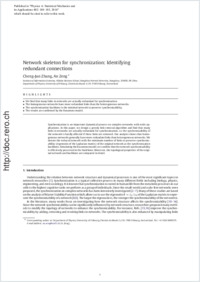Network skeleton for synchronization: Identifying redundant connections
- Zhang, Cheng-Jun Institute of Information Economy, Alibaba Business School, Hangzhou Normal University, China - Department of Physics, University of Fribourg, Switzerland
- Zeng, An Institute of Information Economy, Alibaba Business School, Hangzhou Normal University, China - Department of Physics, University of Fribourg, Switzerland
-
15.05.2014
Published in:
- Physica A: Statistical Mechanics and its Applications. - 2014, vol. 402, p. 180–185
English
Synchronization is an important dynamical process on complex networks with wide applications. In this paper, we design a greedy link removal algorithm and find that many links in networks are actually redundant for synchronization, i.e. the synchronizability of the network is hardly affected if these links are removed. Our analysis shows that homogeneous networks generally have more redundant links than heterogeneous networks. We denote the reduced network with the minimum number of links to preserve synchronizability (eigenratio of the Laplacian matrix) of the original network as the synchronization backbone. Simulating the Kuramoto model, we confirm that the network synchronizability is effectively preserved in the backbone. Moreover, the topological properties of the original network and backbone are compared in detail.
- Faculty
- Faculté des sciences et de médecine
- Department
- Département de Physique
- Language
-
- English
- Classification
- Physics
- License
-
License undefined
- Identifiers
-
- RERO DOC 232356
- DOI 10.1016/j.physa.2014.02.002
- Persistent URL
- https://folia.unifr.ch/unifr/documents/303792
Statistics
Document views: 135
File downloads:
- pdf: 232
